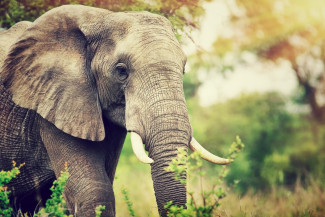
Johns Hopkins UniversityEst. 1876
America’s First Research University
Walker's Mammals of the World

The history of Walker’s Mammals of the World goes back to the 1930s, when Ernest P. Walker, assistant director of the National Zoological Park in Washington, began assembling data and imagery. First published in 1964, it became a Johns Hopkins University Press classic, with editions in 1968 and 1975 edited by John L. Paradiso. John asked me to join the project in 1976, and we co-authored the 1983 edition, setting major new standards of content and organization. Overall text length increased by 50 percent and approximately 90 percent of generic accounts received substantive modification, many being completely rewritten and greatly expanded. We began an effort to list the name and distribution of every species of every genus, to cover all genera and species that lived in historical time (approximately the last 5,000 years), and to provide extensive bioconservation information. I went on to author the 1991 and 1999 editions. Together with renowned authorities, I also authored five “spin-offs” from 1994 to 2005, covering particular groups of mammals.
I thought that would be the end of my participation, but Vincent J. Burke, now JHU Press Editor Emeritus, persuaded me to begin a new phase, in which separate volumes, updating accounts of various orders, might be published over the years. After many delays and difficulties, for which I accept primary responsibility, a volume covering 19 of the 31 historical and modern mammal orders is complete. Additional volumes (there would have to be at least four more of comparative size to cover all orders) may be issued in the future, depending on the reception of this first effort and availability of an author.
I take pride in this new volume, to which I contributed over 7,000 hours. With respect to those orders covered, it represents the most sweeping modification of Walker’s since the publication of the first edition in 1964. Compared to corresponding sections of the 1999 edition, text length has doubled, a proportional increase far greater than in any previous revision. Every old generic account has been substantively changed, 17 accounts of newly described genera have been added, and many separate species accounts have been prepared. Barely 10 percent of the written text is the same as in the relevant portion of the 1975 edition, the last for which Walker is considered primary author. Nonetheless, the book retains major aspects of Walker’s format and, I fervently hope, keeps to his original objective of providing a physical description and a basic account of natural history for each genus of mammal, in a manner that is easily understood and appreciated by the general public but also serves the professional community.

Since research for the 1999 edition ended, more than 20 years ago, there has been an enormous proliferation of mammalogical literature. Much is now available online, though many trips to libraries, purchases of hard copies of books, and requests for reprints were still necessary. Over 2,100 new references are cited in this update and about 900 have been retained from the 1999 edition.
When I finished searching for literature and drafting the text in early 2016, I again thought my work was largely done. However, a decision had been made long before to try to replace the original illustrations, all black-and-white, with new color coverage. Now I found unexpectedly that such would be entirely my responsibility and would be the most intensive part of the entire project. Yet it also became one of the most satisfying, as I received wonderful cooperation from a host of professional and amateur photographers, agencies, and biologists across six continents. The search exceeded my expectations, with a yield of more than 500 new color images, including beautiful photos of live individuals of 90 percent of genera, and scientifically prepared paintings of extinct genera. I believe that Walker, an accomplished photographer himself, would be pleased with the coverage.
Many mammals are declining in response to habitat disruption and direct killing by people. Two massively potential problems are environmentally disruptive global warming and changing human demographics that may upset the societal basis of international wildlife protection. This volume discusses every species, subspecies, and population that is historically extinct or listed in a category of concern by the IUCN, CITES, and USDI. Sadly, because of bureaucratic and political proclivity, the USDI’s List of Endangered and Threatened Wildlife is now almost meaningless as an expression of the extent and diversity of the world’s declining mammals. Enormous resources are devoted not to additions to the List but to delistings based on often spurious claims of recovery. Nonetheless, the U.S. is the greatest hope for global conservation, and may yet resume its leadership role in assuring that Walker’s mammals will remain more than just names and pictures in a book.
Ronald M. Nowak was a staff mammalogist at the former Office of Endangered Species, US Department of the Interior. He is the coauthor of the fourth edition and the author of the fifth and sixth editions of Walker's Mammals of the World.


